
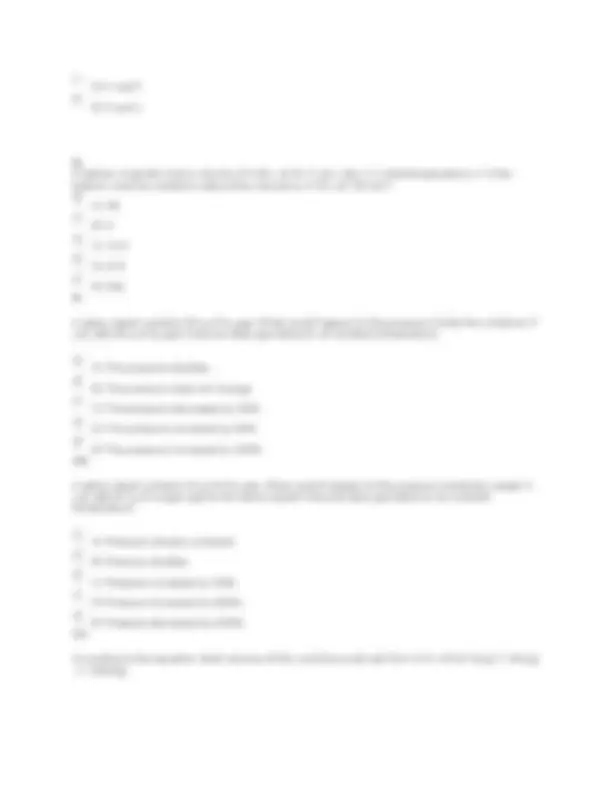
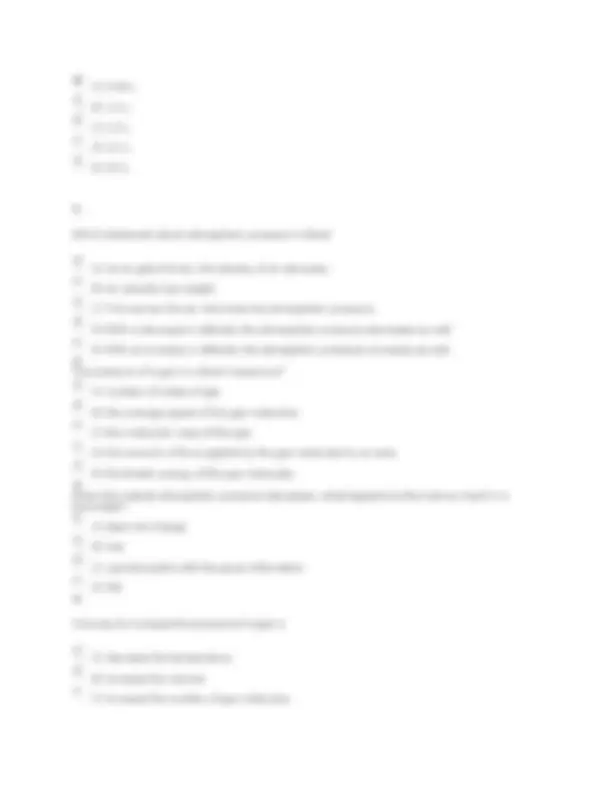

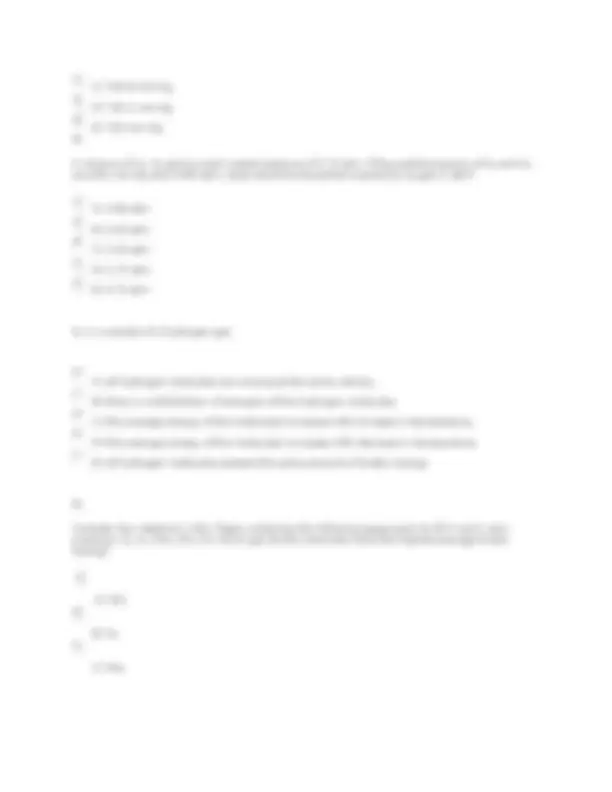
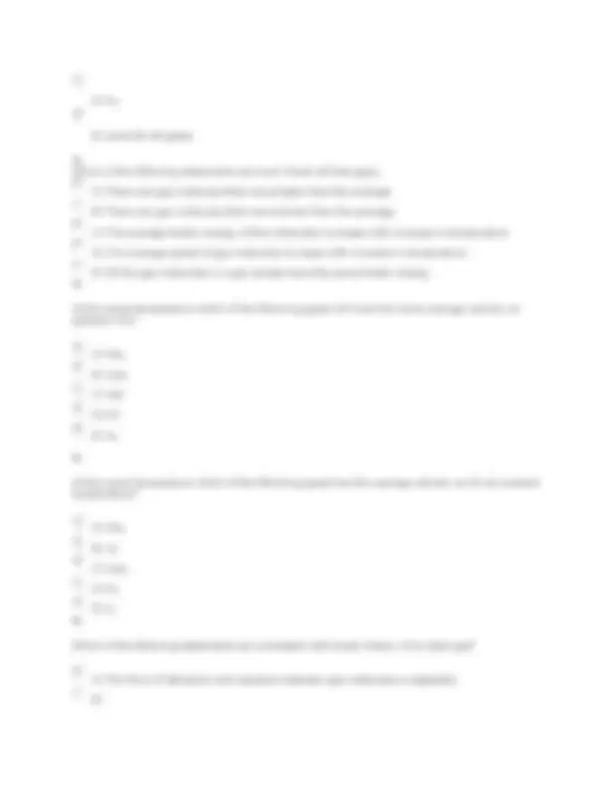
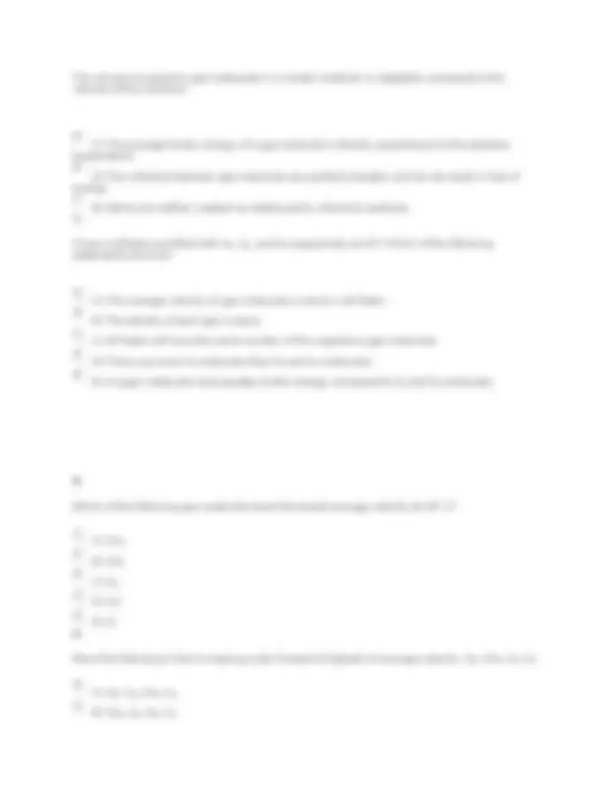



Study with the several resources on Docsity

Earn points by helping other students or get them with a premium plan


Prepare for your exams
Study with the several resources on Docsity

Earn points to download
Earn points by helping other students or get them with a premium plan
Community
Ask the community for help and clear up your study doubts
Discover the best universities in your country according to Docsity users
Free resources
Download our free guides on studying techniques, anxiety management strategies, and thesis advice from Docsity tutors
Material Type: Quiz; Class: General Chemistry Lecture I; Subject: Chemistry; University: Lansing Community College;
Typology: Quizzes
1 / 13

This page cannot be seen from the preview
Don't miss anything!








Which of the following is/are characteristics of a gas? A) higher compressibility B) relatively large distance between the gas molecules C) formation of a homogeneous mixture with other nonreacting gases D) has a definite shape and volume E) has definite volume but takes the shape of the container . Avogadro's law states that A) The volume of a gas is directly proportional to its temperature in Kelvins. B) The volume of a gas is directly proportional to the ideal gas constant. C) The volume of a gas is inversely proportional to the pressure. D) The volume of a gas is directly proportional to the number of moles present. E) The pressure of a gas is directly proportional to the temperature in Kelvins. 2. At a constant temperature, pressure and volume are inversely proportional to each other. A) True B) False 3. At constant pressure, the volume of a gas in inversely proportional to temperature. A) True B) False
The pressure of a gas is 750.0 torr when its volume is 400.0 mL. Calculate the pressure (in atm) if the gas is allowed to expand to 600.0 mL at constant temperature. A) 1. B) 0. C) 500. D) 1125 E) 0. 5. The volume of a gas is increased from 150.0 mL to 350.0 mL by heating it. If the original temperature of the gas was 25.0 °C, what will its final temperature be (in °C)? A) 422°C B) 695°C C) 10.7°C D) 58.3°C E) 2100°C 6. For a gas, which pair of variables are inversely proportional to each other (if all other conditions remain constant)? A) P, T B) P, V C) P, n D) V, T E) V, n 7. For a gas which variables are directly proportional to each other keeping other parameters constant? A) T and V B) P and V C) n and V
Which statement about atmospheric pressure is false? A) As air gets thinner, the density of air decrease. B) Air actually has weight. C) The warmer the air, the lower the atmospheric pressure. D) With a decrease in altitude, the atmospheric pressure decreases as well. E) With an increase in altitude, the atmospheric pressure increases as well. 2. The pressure of a gas is a direct measure of A) number of moles of gas. B) the average speed of the gas molecules. C) the molecular mass of the gas. D) the amount of force applied by the gas molecules to an area E) the kinetic energy of the gas molecules. 3. When the outside atmospheric pressure decreases, what happens to the mercury level in a barometer? A) does not change B) rise C) cannot predict with the given information D) fall 4. One way to increase the pressure of a gas is A) decrease the temperature. B) increase the volume. C) increase the number of gas molecules.
D) decrease the kinetic energy of the gas molecules. E) decrease the number of gas molecules. 5. Pressure of the earth's atmosphere at sea level is ________. A) 1.00 mm Hg B) 1.00 torr C) 760 torr D) 10.0 atm E) 273 torr 6. Pressure of 29.3 inches of mercury is the same as ________. A) 74.4 mm Hg B) 744 mm Hg C) 744 cm Hg D) 0.979 atm E) 744 torr 7. A pressure of 0.925 atm is the same as A) 925 torr. B) 925 mm Hg. C) 703 mm Hg. D) 703 cm Hg. E) 0.925 cm Hg. 8. Convert 2.30 atm into mm Hg. A) 23. B) 2300 C) 175
A) not enough information is given. B) 50. C) 2. D) 8. E) 4. 1. In experiments involving gases collected over water vapor, the formula used to calculate the partial pressure of dry gas is: Pdry gas = PTotal _______ PH2O Fill in the blank with the missing math symbol in the formula. A) X B) / C) + D) - 2. The partial pressure of O 2 on a sample of air was observed to be156 mm Hg on a day when air presure was 743 mm Hg. What was the mole fraction of O 2 present in air? A) 4. B) 21.o C) 0. D) 0. E) 0. 3. A sample of hydrogen gas was collected over water at 22.0 ⁰C.The total pressure measured for the wet gas 745 mm Hg. The vapor pressure of water at 22.0 ⁰C = 19.8 mm Hg. What is the pressure exerted by dry hydrogen gas alone? A) 37.6 mm Hg B) 765 mm Hg
C) 764.8 mm Hg D) 725.2 mm Hg E) 725 mm Hg 4. A mixture of O 2 , N 2 and H 2 exert a total pressure of 2.74 atm. If the partial pressure of O 2 and H 2 are 841 mm Hg and 0.996 atm, what would be the partial exerted by N 2 gas in atm? A) 4.85 atm B) 0.63 atm C) 1.63 atm D) 1.74 atm E) 2.74 atm
1. In a sample of a hydrogen gas, A) all hydrogen molecules are moving at the same velocity. B) there is a distribution of energies of the hydrogen molecules. C) the average energy of the molecules increases with increase in temperature. D) the average energy of the molecules increases with decrease in temperature. E) all hydrogen molecules possess the same amount of kinetic energy. 2. Consider four identical 1.00-L flasks containing the following gases each at 25°C and 1 atm pressure: H 2 , O 2 , NH 3 , SO 2. For which gas do the molecules have the highest-average kinetic energy? A) SO 2 B) H 2 C) NH 3
The volume occupied by gas molecules in a closed container is negligible compared to the volume of the container. C) The average kinetic energy of a gas molecule is directly proportional to the aboslute temperature. D) The collisions between gas molecules are perfectly eleastic and do not result in loss of energy. E) Atoms are neither created nor destroyed by chemical reactions. 7. Three 1.0Lflasks are filled with H 2 , O 2 , and N 2 respectively at STP. Which of the following statements are true? A) The average velocity of gas molecules is same in all flasks. B) The density of each gas is same. C) All flasks will have the same number of the respective gas molecules. D) There are more H 2 molecules than N 2 and O 2 molecules. E) Oxygen molecules have greater kinetic energy compared to H 2 and N 2 molecules. 8. Which of the following gas moelcules have the lowest average velocity at 25⁰ C? A) CO 2 B) CH 4 C) H 2 D) CO E) Ar 9. Place the following in the increasing order (lowest to highest) of average velocity. Xe, CH 4 , O 2 , H 2 A) Xe, O 2 , CH 4 , H 2 B) CH 4 , O 2 , Xe, H 2
C) O 2 , CH 4 , Xe, H 2 D) Xe, O 2 , CH 4 , H 2 E) They all will have the same average velocity. 1. Which of the following would have a higher rate of effusion than C 2 H 2? A) N 2 B) O 2 C) NH 3 D) Cl 2 E) CO 2 2. The rate of effusion of NH 3 is 2.40 mole/min. What is the rate of effusion of He under the smae conditions? A) 0. B) 4. C) 1. D) 2. E) 10. 3. If 0.50 mole of H 2 (g) and 1.0 mole of He(g) are compared at the same temperature and pressure, the two gases will A) have equal effusion rates. B) have equal average molecular velocities. C) have equal average molecular kinetic energies. D) occupy equal volumes. 1. An ideal gas differs from a real gas in that the molecules of an ideal gas
A) is a constant that is same for all gases. B) is a constant that adjusts to the actual volume occupied by the gas molecules. C) is a constant used for ideal gases. D) is a constant that is more significant for gases at STP. E) is a constant that adjusts for the attractive forces between the molecules. 6. In which gas the collisions of the molecules or atoms will be more elastic with no loss of kinetic energy? A) CO 2 B) N 2 C) O 2 D) Ar E) SO 2